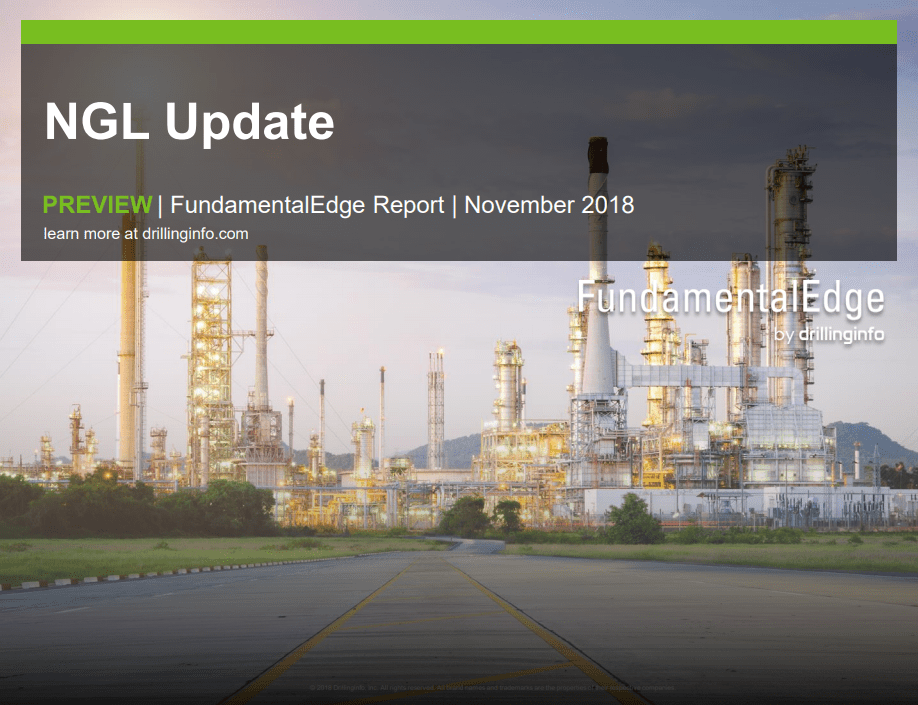20% increase expected in next five years; price volatility likely as industry awaits infrastructure, fractionation and cracker projects to come online
Austin, TX – Drillinginfo, the leading energy SaaS and data analytics company, has released a natural gas liquids (NGL) update, the latest in its FundamentalEdge series reports.
According to the report, NGL production is hitting record highs despite fractionation and infrastructure constraints. NGL fractionation facilities process mixed natural gas liquids streams into purity products such as ethane, propane, normal butane, isobutane and pentane. NGLs are used to make plastics, petrochemical feedstocks, residential and commercial heating and cooking fuels, polystyrene foam and in blending with vehicle fuels such as gasoline.
August marked the eighth record in a row as NGL production reached 4,570 MBbl/d. Drillinginfo projects that production will grow ~5% over the next year and ~21% over the next 5 years, with the highest growth out of the Permian (9% and 35% growth over one and five years, respectively). Prices will likely stay volatile as infrastructure, fractionation, and cracker projects come to fruition.
With record-high supply, fractionation margins, and constrained volumes surrounding the NGL market, several midstream companies have posted significant project announcements to take advantage of the market fundamentals. An overview of these announcements is included in the report.
Key Takeaways from the NGL Update:
- NGL production has hit a record high eight months in a row. Y-grade pipelines, railcars, and fractionators are all next to full. Oversupply and constraints have yielded lower prices, and lower netbacks. There is also increased volatility, which will likely remain at least over the next two to three years as incremental projects are completed and more constraints potentially unfold.
- NGL production keeps growing despite constraints across all other commodities and basins: the Permian has crude and processing issues, the DJ is dealing with line pressures, the Bakken has had a rough maintenance season, and the Mid-Continent battles spacing and productivity. That being said, if all of these issues did not exist, the NGL world would have bigger problems than it does now because of the bottlenecks further down the chain.
- The US NGL market is battling several infrastructure constraints as well, and getting the molecules to Mont Belvieu is one of them. After pipelines are filled, everyone turns to transport by rail. The Permian and Bakken battle their own logistical issues because of the volume of railcars in and out, while also limiting transportation from regions like Appalachia at the same time.
- The Cushing-Mont Belvieu spread continues to be wide because there is simply not enough pipeline space to get to the Gulf Coast. But if it were there, would it have anywhere to go? Fractionation space is the next bottleneck and continues to be tight.
- Many greenfield projects have been announced to increase frac space and take advantage of some of the wide frac margins and optimization opportunities. Some midstream providers have been creative, recommissioning frac space through maintenance, building small pipelines to increase flow optionality, or optimizing volumes on their systems and through storage to create more space.
- There is more frac capacity commissioning in early 2019, but the extra space won’t hold for long. DUCs have been rising steadily, and a ramp in associated production could turn online when crude capacity opens up in the Permian. With more supply could come more bottlenecks, increased Y-grade in storage, and more petchem facilities looking for more feedstock.
Recently, NGL prices have fallen with crude and the increasing domestic and global supply. Producer and marketer netbacks are also down, which is a result of the constraints, as they pay more for spot frac capacity, storage, and transportation to move their barrels. Midstream also suffers lower margins, but still reaps the benefits of the constraints through high utilization of assets, optimization opportunities, and absorbing those premiums from their customers.
